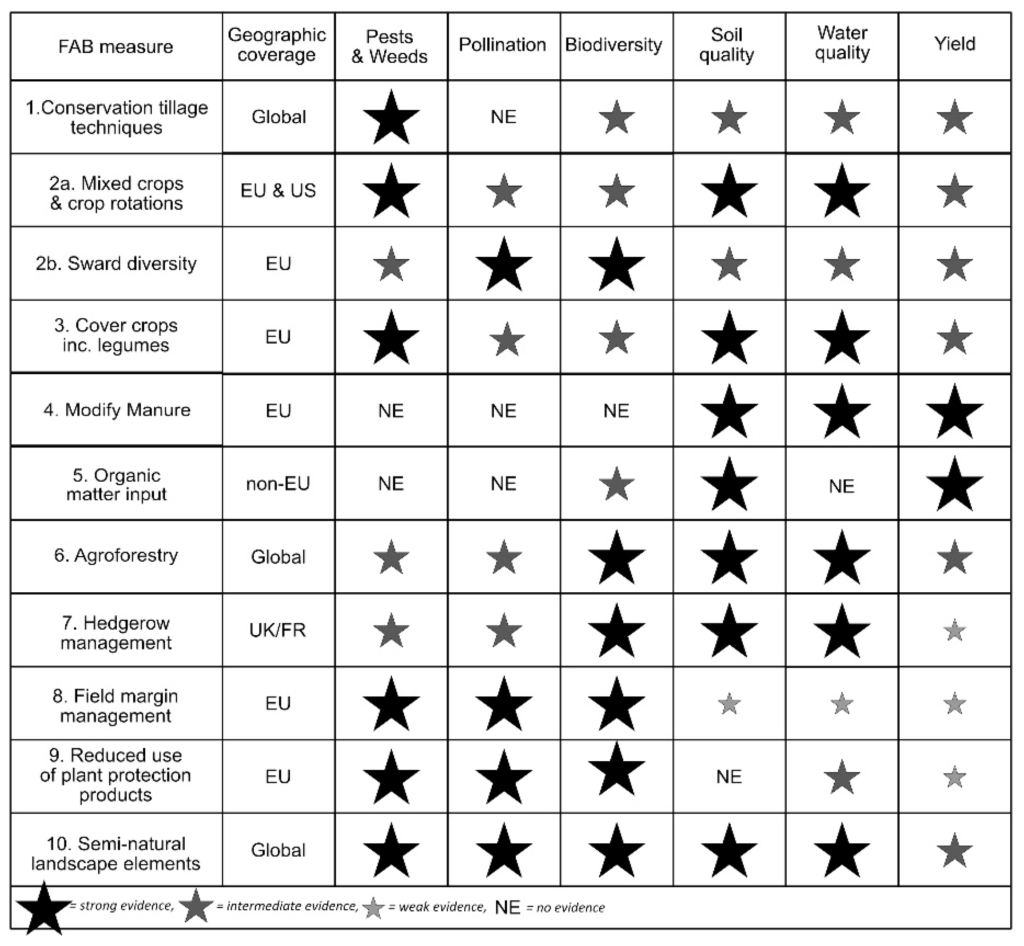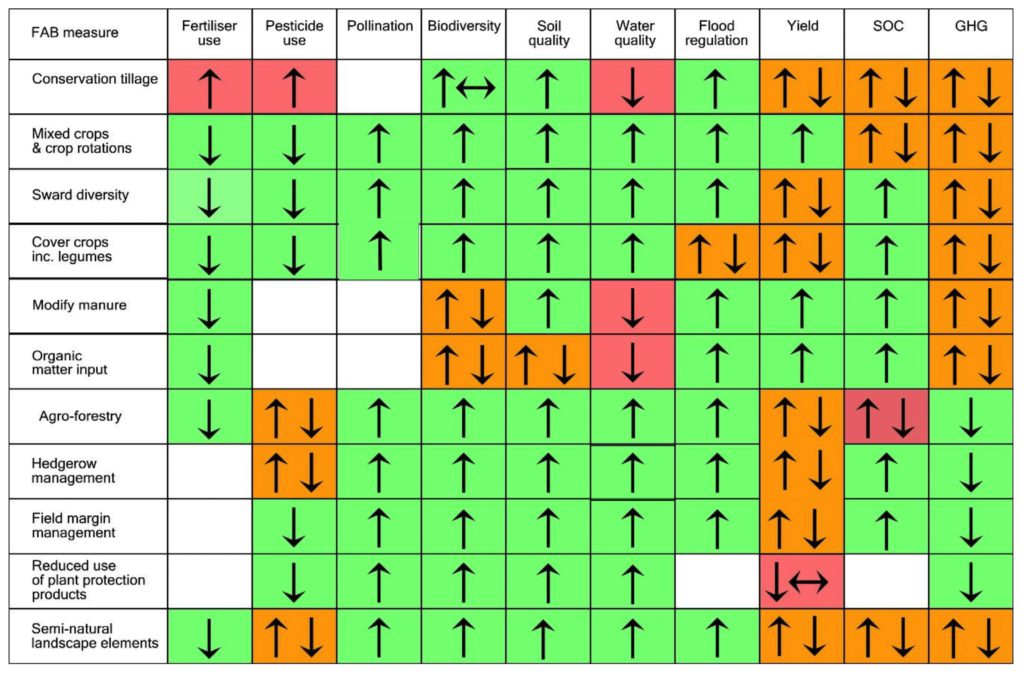
In the first of this series of three articles, we discussed the need to better understand the financial and climate impacts of regenerative farming practices. In this article, we summarise our recent work with SOS-UK (report available here), to contribute to this understanding. This article focuses on the practices themselves and the state-of-the-art regarding what we know about their impacts on farms.
What practices are we talking about?
We started with a focus on the five commonly cited principles of regenerative farming practice:
- Minimise soil disturbance
- Keep soil covered
- Maintain living roots in the soil as much as possible
- Maximise plant diversity
- Integrate livestock
Then we assembled a list of typical farming practices which can support these principles, supporting a more regenerative farming system. In practice, we are clear that where these practices are adopted together, the impact will be greater.
- Reduced tillage
- Introduction of Silvopasture
- Enhanced hedge management
- Introduction of herbal leys
- Replacement of monoculture ryegrass swards with grass/ clover swards
- Holistic grazing
- Maximisation of forage in dairy cow diets
- Improved use of manures and composts
- Introduction of cover cropping
- Introduction of longer crop rotations
- Retention and incorporation of crop residues
- Introduction of Agroforestry
- Intercropping/ companion cropping
- Use of living mulches
- Winter grazing of cereals
What’s the evidence for their impacts?
We assessed a range of evidence for the sustainability and financial impacts of the farming practices described above. Of the various papers and reports we assessed, we highlight two reports in this article, which we felt were helpful in bringing together evidence on sustainability impacts. First, the recently published paper by Maskell et al. 2023, Functional Agro Biodiversity: An Evaluation of Current Approaches and Outcomes. This paper contains some of the most up-to-date analysis of the state of the art and contains two key tables which are reproduced here. The first table assesses the strength of the evidence for the impact of key practices which are considered to support enhanced Functional Agro Biodiversity (FAB). This list shows that the strongest evidence for the impact of these practices is on soil health (>60% of practices have strong evidence for impact). By contrast, less than 20% of practices have any evidence of impact on crop yield. For water quality, biodiversity and control of pests and weeds more than 50% of the practices listed have strong evidence of impact.

The second table brings together findings from a wide range of research in recent years to identify the contributions of these farming practices to ecosystem service provision and farm management. Again, what stands out is the low level of reporting of any improvements in crop yield from adopting these practices. In general, the reverse has been found more commonly. Similarly, conflicting findings on the impact of these practices on GHG emissions are present. However, there is a clear consensus for the positive impact of the vast majority of the practices listed on pollination, biodiversity, soil and water quality, alongside flood regulation. In fact, all the elements of ecosystem service provision are enhanced through the adoption of these practices.

Table notes: GHG= GHG emissions, SOC= Soil Organic carbon, ↓=Decrease; ↔= no significant effect, ↑= Increase. The cells have been shaded green (positive effect on ES), red (negative effect on ES), orange (mixed). Presence of multiple arrows indicates good evidence for different effects, often depending on specific context.
As a follow-up to the likely impact of these practices on soil carbon sequestration, we carried out desk research to identify the likely range in potential for some of these practices. We reviewed a report produced in January 2022, led by the Green Alliance for the Oxford Farming Conference, which reviewed the evidence for soil carbon removals and reduction in emissions following the adoption of some “more regenerative farming” practices and land management changes. The authors reported a relative scarcity of robust data for the impacts on soil carbon stocks arising from a shortened range of farming practices. In addition, a large range of results was found from some practices (see Table 3), which makes it difficult to assign any specific level of carbon removal or reduction in emissions without measurement.
| Practice | Land efficiency tCo2e/ha/yr | Source of data | Total UK potential MtCo2e/yr | Assumptions |
|---|---|---|---|---|
| Paludiculture | 19.0 – 39.0* | C Evans et al, 2017 | 2.0 – 4.1* | 25% of lowland peat drained for agriculture becomes paludiculture to meet CCC targets |
| Halving drainage depths for arable on peat | 12.7 – 18.9* | C Evans et al, 2021 | 5.3 – 7.9* | Drainage depth halved on all drained lowland peat |
| Agroforestry | 4.4 – 10.0(mainly tropical data so likely a lower range in the UK) | D Kim et al, 2016 | 1.8 – 4.2 | Adoption at 416,700 hectares, A Thomson et al, 2018 |
| Hedgerows | 3.1 – 7.3 | S Drexler et al, 2021 | 0.5 – 1.2 | Adoption at 168,200 hectares, A Thomson et al, 2018 |
| Organic matter incorporation from residues or amendments | -0.9 – 2.3 depending on clay content in soil | C Poeplau et al, 2015 | -1.1 – 2.8 | Mid – range rate, adoption at a third of arable area |
| No till system as part of conservation agriculture | 0.3 – 0.6 | S Jayarama et al, 2021 | 0.4 – 0.7 | Mid – range rate, adoption at a third of arable area |
Agroforestry and hedgerows are the best on-farm measures for carbon sequestration but will need management of woody biomass to sustain sequestration as the trees and hedges reach maturity. While soil carbon measures have low potential per hectare, and appear to be limited in terms of the length of sequestration possible, they have perhaps the highest potential for adoption whilst also keeping land in food production.
In the next article, we focus on what we found out: which regenerative farming practices have the most potential for reducing greenhouse gas emissions together with the financial impact of their adoption. You can also read the previous article on this topic here.

